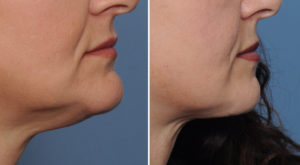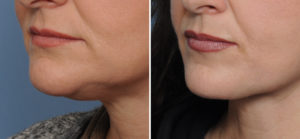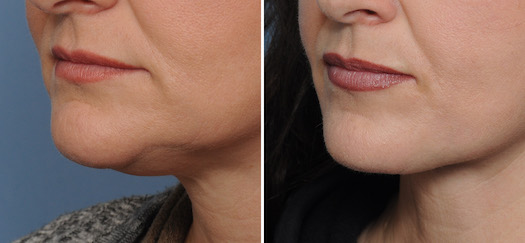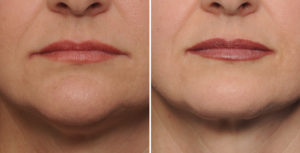Background: Chin reduction is a challenging operation that involves multiple tissue considerations. Reducing the bone by either osteotomy or shaving is the most straightforward aspect of the procedure and also the most predictable. What is often overlooked and is the most unpredictable part of chin reduction surgery is how the overlying soft tissues will respond.
Just because the bone is reduced there is no guarantee that the enveloping soft tissue chin pad will similarly assume the same shape. It is not like liposuction where the overlying skin, which is much flatter in shape and more pliable, can fairlyeasily shrink down if its elastic fibers have not been disrupted. The soft tissue chin pad is not flat but a curved soft tissue cover that is stretched over the end of the chin bone. It already is fairly tight and it has a muscle layer with an origin and insertion points underneath it. It is this anatomic arrangement that results in so many cases of Witch’s chin and chin pad irregularities when only bone reduction is done, particularly intraoral shaving or osteotomy setbacks.
While not every chin reduction needs soft tissue management, many do. If any bone reduction is being done by shaving either from an intraoral or submental approach, soft tissue reduction will also be needed. If bone reduction is done by osteotomy and the inferior soft tissue chin pad remains intact (e.g., t-shaped chin osteotomy or vertical wedge reduction osteotomy) then soft tissue management may not be needed. This is because the maintained soft tissue attachments allow it to follow the bone movement more closely.
The predictability of the need for soft tissue reduction is also based on the bone dimensions being changed. Large bony reductions in any one single dimension or multiple dimensional bony reductions are likely indications for surgically assisting the overlying soft tissue response to it.
Case Study: This female presented for chin reduction. She had long been bothered by the shape of her chin, feeling like it was shaped like a ball, was too vertically long and horizontally protrusive and submental fullness below the chin.
Under local anesthesia and IV sedation, a submental approach was taken to her chin reduction. Vertical reduction was done by inferior border having and some slight horizontal bone reduction as well. The inferior soft tissue chin pas was excised in a crescent pattern (submental tuck) as well as submental liposuction.


Chin reduction is challenging and it is difficult to get all dimensions reduced with an acceptable scar all at one time when a submental technique is used. Since there is no erasing a scar once it is placed, the primary chin reduction procedure should not let the extent of the scar become excessive in the effort to maximally reduce the soft tissue chin pad. It is far better to use good judgment and keep the excision pattern at an acceptable scar length as it can always be extended secondarily at the patient discretion.
Case Highlights:
1) Chin reduction is a challenging operation that most consider both the bone and the overlying soft tissue.
2) With loss of bone support the ability of the overlying soft tissue to contract down around is limited.
3) Reducing or tightening the soft tissue chin pad can only be done from a submental approach.
4) The revision rate of chin reduction is fairly high and one should think of the procedure as one that likely requires two stages to achieve an optimal result.
Dr. Barry Eppley
Indianapolis, Indiana




